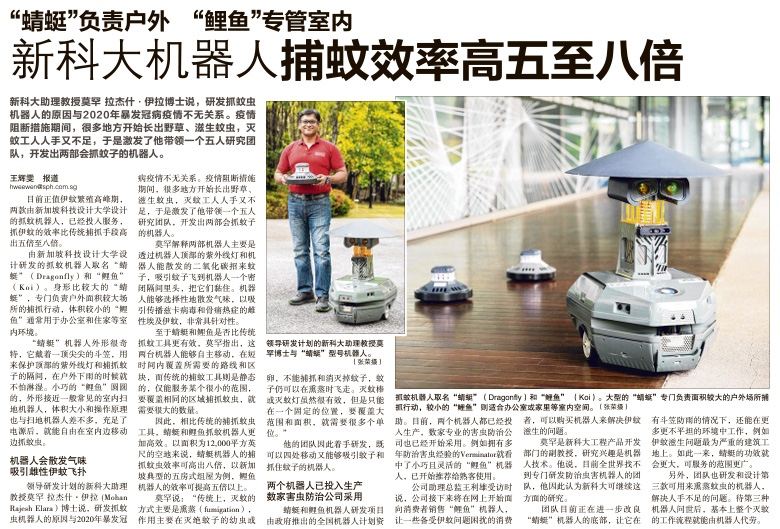SUTD’s robot catches mosquitoes five to eight times more efficiently
Lianhe Zaobao, 3 Jul 2023, 新科大机器人抓伊蚊效率高五至八倍
Amid the current peak breeding season for the Aedes mosquitoes, two mosquito-catching robots designed by the Singapore University of Technology and Design have been put into operation. The efficiency of catching Aedes mosquitoes is five to eight times higher than that of traditional methods.
The mosquito-catching robots designed and developed by the Singapore University of Technology and Design (SUTD) are named 'Dragonfly' and 'Koi'. The relatively large Dragonfly is responsible for catching mosquitoes at large outdoor places, and the smaller Koi is usually used in indoor environments such as offices and homes.
The design of the Dragonfly robot is very peculiar. It wears a pointed hat to protect the ultraviolet lamp on its "head" and the compartment for catching mosquitoes. It is also not afraid of getting wet when it rains outdoors. The smaller Koi is round, and its shape is like the common indoor cleaning robots. Its size and operating principles are also similar to those of cleaning robots. With sufficient power supply, it can move freely indoors while catching mosquitoes.
Robot emits scent to attract female Aedes mosquitoes
SUTD’s Associate Professor Mohan Rajesh Elara, who is leading the research and development project, said that the reason for developing the mosquito-catching robot is not unrelated to the outbreak of the new Coronavirus disease in 2020. During the circuit breaker period, weeds began to grow in many places, breeding mosquitoes, and there was a shortage of mosquito exterminators. This inspired him to lead a five-person research team to develop two robots for catching mosquitoes.
Mohan explained that the two robots mainly attract mosquitoes through the ultraviolet light on the top of the robot, and the carbon dioxide emitted by the robot attracts the mosquitoes to fly to a closed compartment of the robot, causing them to stick. The robot is also able to selectively emit scents to specifically attract female Aedes aegypti mosquitoes, which transmit Zika virus and dengue fever.
As for whether Dragonfly and Koi are more effective than traditional mosquito-catching tools, Mohan pointed out that the two robots can move autonomously and cover the required routes and blocks in a short time, while traditional mosquito-catching tools are static and can only serve a small area. A large number will be required in order to cover the same area to catch mosquitoes.
Therefore, the Dragonfly and Koi mosquito-catching robots are more efficient than traditional mosquito-catching tools. For an open space with an area of 12,000 square feet, the efficiency of the Dragonfly robot in catching mosquitoes can be eight times higher. Taking a typical five-room HDB flat in Singapore as an example, the efficiency of the Koi robot can be increased by more than five times.
Mohan said: "Traditionally, fumigation is the main way to kill mosquitoes. Its main function is to exterminate mosquito larvae or eggs. Mosquitoes cannot be captured and eliminated. Mosquitoes can still fly away during fumigation. Although mosquito sticks and mosquito killer lamps are very effective, they can only be used in one fixed position, and to cover a large area and surroundings, many units are needed."
So his team set out to develop robots that could both move around and attract and catch mosquitoes.
Both robots already in production, adopted by several pest control companies
The Dragonfly and Koi robot research and development projects are funded by the government launched the National Robotics Programme. Both robots are already in production, and several professional pest control companies are using them. For example, Verminator, which has many years of experience in pest control, has taken a fancy to the small and flexible Koi robot and has begun to recommend it to its regular customers.
Brian Ong, assistant director of the company, said in an interview that the company will start selling Koi robots to consumers online, so that some consumers who are faced with the issue of Aedes mosquitoes can buy the robots to solve the problem of mosquito-breeding.
Mohan is an associate professor in SUTD's Engineering Product Development pillar with a keen interest in robotics. He said that there is currently no team in the world that specialises in the development of pest control robots, so he believes that SUTD can continue research in this area.
His team is currently further improving the base of the Dragonfly robot, with a cover to protect it from the rain, so that it can work in more uneven terrains, such as construction sites where the breeding of Aedes mosquitoes is a very serious problem. In this way, the efficacy of the Dragonfly will be greater, and its scope of service will be wider.
Additionally, the team is also developing and designing a third robot that can be used to fumigate mosquitoes to solve the problem of insufficient manpower in this area. After the advent of the third robot, basically the entire workflow of mosquito control can be done by robots.
